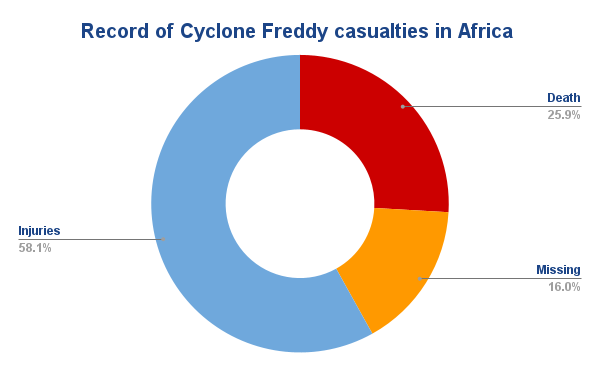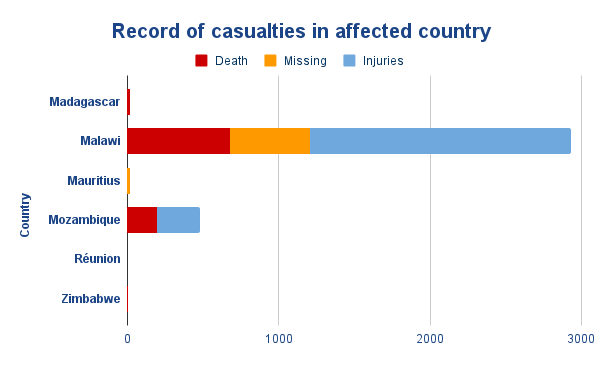Tropical cyclones are not novel in human history. The earliest and most deadly cyclone, The Great Gale, dates back to 1878. Between 1878 and 2023, the world experienced over 1,000 tropical cyclones resulting in the death of over 2.6 million people across the world. In meteorology, a cyclone is “a large air mass that rotates around a strong centre of low atmospheric pressure, counterclockwise in the Northern Hemisphere and clockwise in the Southern Hemisphere as viewed from above (opposite to an anticyclone)”. The practice of naming cyclones started decades ago to simply ease the quick identification of cyclones by the regions, thereby increasing disaster risk awareness, preparedness, management and reduction. According to the World Meteorological Organization (WMO), there is a strict procedure for the naming of cyclones and they are named according to the rules at a regional level. Of course, this article is not about the naming of cyclones. We are interested in how Cyclone Freddy has exposed Africa’s climate crisis susceptibility due to its disaster risk unpreparedness, weak climate crisis management system and poor adaptive capacity.
In February 2023, Freddy first developed as a mere disturbance. It intensified into a Category 4 severe tropical cyclone in the Australian region cyclone basin and crossed to the South West Indian Ocean basin (SWIOB) where it intensified more. From the SWIOB, it travelled more than 8,000 km (4,970 miles) and made its first landfall in Mananjary, Madagascar and second landfall south of Vilankulos town, Mozambique. Then it circled back to the coast of Mozambique after two weeks, before finally moving to Malawi. The severity of a cyclone is consequent to rapid intensification, which the United States National Hurricane Center defines as “an increase in the maximum sustained winds of a tropical cyclone of at least 30 knots (35 mph; 55 km/h) in a 24-hour period”. Ordinarily, tropical cyclones require warm sea surface temperatures (SST) or ocean surface temperature (OST) to form and strengthen, but its intensification occurs when the SST level or OST level is higher. According to Richard Knabb, PhD, Director of NOAA’s National Hurricane Center, “Rapid intensification happens when a tropical cyclone that already has some organization moves over very warm water and within an atmospheric environment of calm surrounding conditions and a moist, unstable air mass”. Freddy’s rapid intensification started in the Australian region cyclone basin and further intensified when it crossed the South West Indian Ocean before making landfall in Madagascar. In fact, the WMO established that Freddy had seven separate cycles of rapid intensification. Simply put, at each point when Freddy crossed a sea or an ocean, the high SST or OST of that sea triggered its rapid intensification – hence its severity.
Ultimately, the subject matter of high sea surface temperature (SST) or high ocean surface temperature (OST) cannot but lead to a discussion on greenhouse gas emissions, global warming and climate change. The average SST or OST is about 20° C (68° F), but it ranges from more than 30° C (86° F) in warm tropical regions to less than 0°C at high latitudes. Research has shown that SST has been on a steady rise since the 20th century (see graph below). The graph below shows how the average SST or OST of the world’s oceans has changed since 1880. From 1901 through 2020, SST has been on an average rise of 0.14°F per decade.

The steady rise of SST and OST is an unavoidable consequence of increased concentrations of greenhouse gasses in the atmosphere, mainly from fossil fuel consumption. Sea surface temperature (SST) or ocean surface temperature (OST) is the water temperature that is close to the ocean’s surface. When this water temperature warms, two things happen: it expands as its temperature increases, and then it melts glaciers and ice sheets. These two occurrences increase sea surface temperatures, and consequently, sea levels. Now, the rising sea levels lead to greater coastal erosion, stripping the coast of its natural protection consisting of sediment and wetlands – hence the increase in intensity and frequency of extreme weather events like cyclones, hurricanes, and storm surges.
Africa historically and currently emits a very small amount of CO2. According to Our World in Data report, the continent contributes only 3% to the global emission(see chart below) but it is not exempted from the devastating effects of extreme weather events resulting from fossil fuels burning by developed countries.

In fact, Elizabeth J. Kendon and others (April 2019) in their study of climate models and weather in Africa over the next 80 years considered the continent most vulnerable to climate change. Africa is deemed as the most vulnerable for two major reasons: first, it has a weak adaptive capacity, high dependence on ecosystem goods for livelihoods, and less developed agricultural production systems. Second, the continent is warming faster than the rest of the world on average. According to Elizabeth, “Essentially, we have found that both ends of Africa’s weather extremes will get more severe. The wet extreme will get worse, but also the appearance of dry spells during the growing season will also get more severe”. This signifies that recent extreme weather events in the continent like Cyclone Freddy are just a primer for what is yet to come. Records show that the recent Cyclone Freddy disaster resulted in 3,452 total casualties across five African countries – 894 deaths, 554 missing persons and 2,004 injured persons(See charts below):


Malawi specifically recorded the highest number of casualties in the recent Freddy disaster. In addition to the 676 deaths, 533 missing persons, and 1,724 injured persons that are represented in the above chart, nearly 490,100 people were displaced and sheltered in over 500 sites across flood-affected areas of Malawi, according to OCHA. This severe impact in Malawi is particularly due to an ongoing cholera outbreak in the country, which Freddy exacerbated. Mozambique recorded the second-highest casualties. In addition, over 66,000 hectares of agricultural land have been affected in Mozambique. Small-scale farmers were harvesting their maize, and preparing for May’s rice harvest when Freddy hit the country. In Madagascar, there are reports of damaged roads and irrigation infrastructure – over 60% of the young rice crop was destroyed. Africa has no proper agricultural storage system to survive in coming years – hence, poverty and heightened food insecurity are looming, in addition to the inevitable public health crisis. This reveals how the continent’s weak systems and infrastructures make it immensely vulnerable to the impact of climate change.
As the fight to reduce the negative impacts of climate change in Africa persists, it beacons on every nation in the continent to strengthen Africa’s disaster defence system by building prompt climate crisis management systems, efficient health care systems, mitigation and adaptation strategies in the management of the ecosystem’s goods and services, vibrant agriculture production and storage systems etc with a strong pan African spirit. Also, research has shown that in the coming years, large portions of the continent may become uninhabitable as a result of the rapid effects of climate change. Additionally, this will ultimately skyrocket the existing rate of poverty, food insecurity and health crisis in the continent, it will also render millions of Africans homeless. Hence, African nations need to also create adequate plans and strategies that would aid the survival of people in the affected areas.
In addition, there is a need for an integrated approach to the phase-out of greenhouse gasses. A global one-size-fits-all strategy would be ineffectual because countries differ in terms of their financial capacity, innovative capacity, population, greenhouse gas dependence etc. Hence, it behoves every country to build long-term strategies that suit their peculiarity and religiously execute them. Loss and Damage relief packages, funding and climate tech innovations are only some of the solutions required for the climate transition.
About the Author(s)
Olayide Oyeleke is an associate at The AR Initiative; where Dr Emma Etim is the Head of Research.